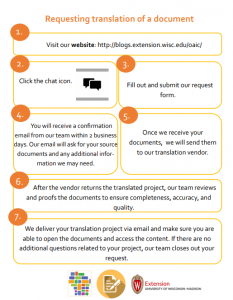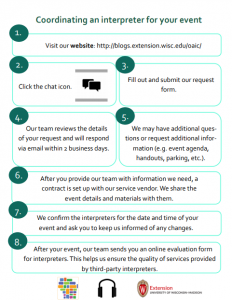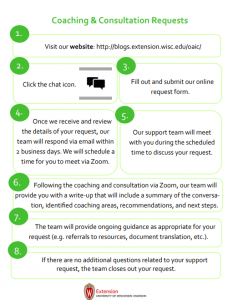These resource documents are intended to support Extension professionals in providing equitable, accessible, and inclusive programming. The content is informed by peer-reviewed research and other sources of information the OAIC considers to be credible, evidence-based practices.
This library is organized by our mission to focus our work on Access, Inclusion, and Compliance. Below, the content is formed around the following categories:
- Requesting our services
- Coaching & Consultation
- Language Access Services
- Expanding Access
- Inclusion
- Compliance (Forms & Statements)
- Disability resources
- Informational Articles by OAIC
Requesting our services
Click on the links below to access the document:
The documents below provide Extension colleagues the tools and steps necessary to request services through OAIC.
C001. Requesting translations through OAIC
This document provides a step-by-step process of what requesters can expect of our translation coordination process.
Coaching & Consultation
Click on the links below to access the document:
The documents below provide topic tips on what colleagues can expect from OAIC and how to optimize their time with our team during their coaching & consultation session.
C003. Coaching & Consultation Requests
This document provides a step-by-step process of what requesters can expect of our coaching & consultation process.
C004. Coaching & Consultation checklist
This document provides requesters with a brief overview of what to prepare and they can expect from the OAIC team during a coaching & consultation session.
Language Access Services
The documents below provide Extension colleagues the tools and steps necessary to understand the processes with working the Language Access team to coordinate translation and interpretation services. The following sections are organized by general Language Access information, translation specific documents, and interpretation specific documents.
General Language Access documents
Click on the links below to access the document:
D021. Language Access Team Services
This document provides a brief overview of the Language Access Team’s services.
D003. Budgeting your translation or interpretation project
This document provides a brief overview of how you can budget for translation and interpretation projects.
D008. Documenting Efforts to Serve LEP Audiences
This document outlines ways for Extension colleagues to keep track of their efforts towards providing services for LEP audiences.
D004. Can bilingual staff, volunteers, or minors interpret/translate?
This document is designed to help Extension staff better understand the limited circumstances when use of non-professional interpreters (oral) or translators (written) is permissible.
E001. Designing multilingual flyers
This document provides brief tips to creating multilingual flyers designed for outreach to multilingual communities.
E010. Developing Multilingual Web Spaces
This document provides information colleagues can utilize to create multilingual spaces. By outlining structures, knowing when to translate text, and more, colleagues can work to build a multilingual web space.
LanguageLine Quick Reference Guide
This document provides Extension staff specific information relevant to accessing the LanguageLine services such as phone number and invoicing information. If you are unable to access your code through your AED, please contact OAIC.
LanguageLine Partnering with and Accessing an Interpreter
This document provides step by step instructions on how to use LanguageLine.
LanguageLine Materials Reference Guide
This webpage provides information on how to access physical documents for LanguageLine. If you need assistance, please contact OAIC.
Translation
Click on the links below to access the document:
The documents below detail topic tips that help colleagues navigate the translation process with our Language Access team. Translation materials are text-based materials which may include fact sheets, brochures, newsletters, outreach materials, program materials, or any website content.
D013. Translation
This document presents an overview of OAIC’s translation management process
D005. Tips for managing your translation project
This document describes the types of projects that the Language Access team works on and specific details to working on translation projects.
D010. Should you translate documents for outreach?
This document outlines when it is appropriate to translate documents.
Interpretation
Click on the links below to access the document:
The documents below detail topic tips that help colleagues navigate the interpretation process with our Language Access team. Interpretation services relate to oral programming such as workshops, trainings, conferences, and delegations/international partnerships.
D012. Interpretation
This document presents an overview of OAIC’s interpretation management process.
D002. Hosting programs with interpreter services
This document explains how program leads can work with interpreters to ensure smooth interpretation for LEP individuals
D006. Working with interpreters for your program event
This document provides requesters a comprehensive checklist for working with interpreters for their programming.
D001. Working with interpreters: a guide for guest presenters
This document provides information to speakers and presenters on how to work with interpreters for in-person programming.
D009. Managing Zoom Interpretation
This document provides a step-by-step process for setting up Zoom interpretation before, during, and after your event.
D011. How to use Zoom interpretation – In Spanish
This document outlines in Spanish how-tos to Zoom interpretation.
D011. How to use Zoom interpretation – In Spanish
This document outlines in Spanish how-tos to Zoom interpretation.
How to use Zoom interpretation – in HMoob
This document outlines in HMoob (Hmong) how-tos to Zoom interpretation.
Setting up Zoom interpretation
This video is part one of a four part series on Zoom interpretation. This video explains to colleagues how to set up Zoom interpretation.
Online event hosts and Zoom interpretation
This video is part two of a four part series on Zoom interpretation. This video explains to colleagues how coordinate with the language access team to set up their Zoom interpretation event.
Online event presenters and Zoom interpretation
This video is part three of a four part series on Zoom interpretation. This video explains to colleagues on how they can lead their Zoom interpretation event on the day of the event.
How to use Zoom interpretation
This video is part four of a four part series on Zoom interpretation. This video explains to participants on how they can use the Zoom interpretation feature at their online event.
How to use Zoom interpretation – Spanish
This video is part four of a four part series on Zoom interpretation. This video explains to participants on how they can use the Zoom interpretation feature at their online event in Spanish
How to use Zoom interpretation – HMoob
This video is part four of a four part series on Zoom interpretation. This video explains to participants on how they can use the Zoom interpretation feature at their online event in HMoob.
Expanding Access
“Expanding Access” refers to Extension’s public-service mission and the programs and services it provides across the state. It is outward-facing, intentional, and involves varied approaches to address disparities from both modern and historical perspectives. Expanding access is aimed at providing programming that is both culturally responsive and linguistically appropriate, and with attention to the needs of the state’s populations that are underserved and underrepresented. The documents below provide topic tips to colleagues on building relationships and expanding access to their programming.
Relationship Building
Click on the links below to access the document:
The documents below provide Extension colleagues with topic tips on building relationships with underserved or underrepresented communities. Relationship building with communities can be a complex process and the documents below provide beginning steps.
E002. How to build meaningful relationships with other organizations
This document creates a foundation for initiating the relationship-building process with organizations external to Extension.
E003. Foundations to building meaningful relationships with communities
This document creates a foundation for initiating the relationship-building process with local communities.
E007. Tips for making your documents more inclusive
This document provides tips on how colleagues can work to make their documents more inclusive towards broader audiences beyond the translation of materials.
Moving towards equitable programming
Click on the links below to access the document:
The documents below provide colleagues with topic tips on how to incorporate more equitable practices in their programming. These practices range from acknowledgments to the incorporation of new materials for programming.
E004. Facilitating a discussion around topics of diversity & inclusion
This document provides brief tips to creating a space for topics around diversity & inclusion.
E005. Creating QR codes
This document provides a brief outline of the benefits of using QR codes to share information to non-English audiences.
E011. Culturally Responsive Practices (CRP): Content development & implementation
This document provides strategies for creating and implementing culturally responsive strategies for Extension programming.
Resources to inform your outreach and programming efforts
This document provides links to a variety of data resources. It is not intended to be an exhaustive list.
Collaborate with colleagues; program and geographic leaders; and local partners, school districts, and
county entities to explore, analyze, and contextualize additional data relevant to your
community and your specific work.
Inclusion
Click on the links below to access the document:
“Inclusion” refers to Extension’s inward-facing culture as a workplace, including the spaces where our work is carried out. Inclusive excellence aims to foster an organizational ethos of respect, collaboration, and accountability among our colleagues, community stakeholders, and members of the public.
Developing descriptions for diverse hiring
Extension commits itself to intentionally recruiting a diverse workforce. This document outlines the practices that can be utilized
in creating job descriptions that meaningfully intend to recruit diverse candidates.
Compliance (Forms and Statements)
Click on the links below to access the document:
“Compliance” refers to the alignment of organizational structures, practices, and policies that are anchored by, but extend beyond, the established minimum legal standards for providing equitable access to programs and services in accordance with Title VI and VII of the Civil Rights Act of 1964 and other sources of federal law and policy.
B001. Demographic Form Template
B006. Partner nondiscrimination letter
To help us ensure that our partners do not intentionally discriminate, we ask that they complete an Assurance of Nondiscrimination by Partner Organization.
- Guidelines (PDF)
Template (download document)
- FAQs (PDF)
B002. Photo Release form (English, Spanish, and Hmong)
To help us ensure the privacy of our participants, we provide the following forms to ask for permissions in photo release.
C007. When is Extension legally responsible for translating text-based materials?
This document is a flowchart used to help colleagues understand when Extension should translate materials under legal responsibility.
Your Right to Translation and Interpretation Services brochure
This brochure can be printed by County Extension staff to handout to participants to notify them of their right to language access services.
Your Right Poster Legal size
This poster can be displayed in County offices to notify participants of their right to language access services.
Your Right Poster Letter size
This poster can be handed out in County offices to notify participants of their right to language access services.
Elements of a linguistically inclusive learning space
This poster displays the elements of an inclusive learning space with simultaneous language interpretation.
Disability Resources
Click on the links below to access the document:
Taglines
Taglines communicate points of access to potential participants so that they know what to
expect at an event. They give relevant information on who to contact for accommodations in
order to participate and gain access. Taglines generally promote inclusion
Informational articles by OAIC
Click on the links below to access these articles
The documents below provide a one-stop access point to OAIC’s informational articles that have been featured on previous Expanding Access Quarterly newsletters.
F001. The emerging preference for “HMoob” as a term of self-identification
This article describes the change from the usage of “Hmong” to “HMoob” in written texts to move towards efforts of inclusivity towards HMoob communities.
F002. Dear Asians Initiative: How translation has opened the door to allyship
This article addresses the anti-blackness that exists in Asian American communities and how the Dear Asians Initiative and similar movements have helped create allyship between Black communities and other Asian American communities.
F003. The emergence of “BIPOC”: What it means and how it is used
This article lays out the definition of BIPOC and addresses the history of language labeling and how BIPOC emerged and is used today.
F004. What does system change look like?
This article addresses the ways in which Extension and Extension colleagues can work towards systemic change and initiating anti-racist work.
F005. Xenophobia: Addressing the pandemic nature of a social virus
This article addresses the xenophobia against Asian Americans that has occurred in the midst of the COVID-19 pandemic.
F006. Accessibility in the time of COVID-19
This article establishes the necessity of accessibility during the COVID-19 and ways to implement changes in programming to ensure accessibility.
F007. Issues in brief: Representation matters
This article addresses the Homecoming video that was published on behalf of UW Madison and how it impacts the communities of color associated with the university.
F008. OAIC celebrates its first birthday!
This article highlights some of the things projects that OAIC brought to bring a more strategic and coordinated approach to equity, diversity, and inclusion in its first year.
F009.30 years of civil rights for people with disabilities Celebrating the ADA
This article highlights the history and impact of the Americans with Disabilities act and its direct impact on Extension programming.
F010. Checking in following the Chauvin trial verdict
This article is a reflection piece from Dominic Ledesma on the Chauvin trial verdict and how it has impacted Extension and its future.
F011. Focus on accessibility: Anatomy of a disability accommodation
This article is a dialogue with Heather Stelljes, Extension’s Disability Access Consultant, and Jayna Hintz, an Educator in Ozaukee County, demonstrating what a disability accommodation can look like and the impact that it can have on the recipient.
F012. Civil Rights Reviews Show Progress & Opportunities
This article is a reflection piece from Kim Waldman, Extension’s Compliance Coordinator and Equity Strategist, on how Civil Rights Reviews work beyond document filing and legal standards and are demonstrations of Extension’s commitment to expand access.
F013. 38th Street & Chicago Avenue: The Intersection of Healing and Hope
This article is a reflection piece from Dominic Ledesma from when he visited the intersection where George Floyd’s murder occurred.






